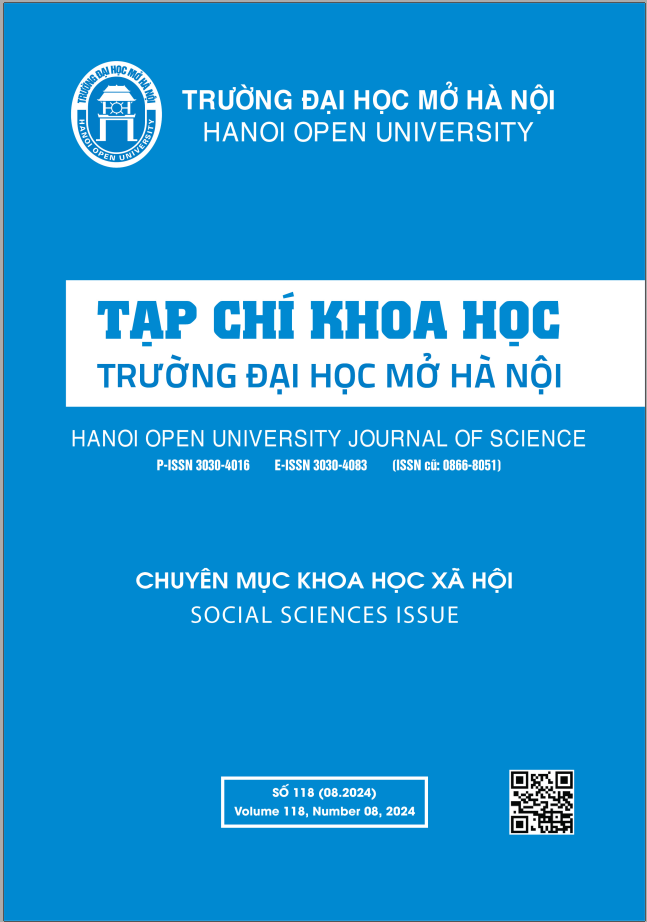IMPACT OF SOCIAL CONNECTEDNESS ON FOREIGN INVESTMENT CAPITAL: EVIDENCE FROM ASIAN COUNTRIES INVESTING IN VIETNAM
DOI:
https://doi.org/10.59266/houjs.2024.449Từ khóa:
Foreign direct investment (FDI), Social network, Facebook social network, Social connectedness index (SCI)Tóm tắt
This study examines the correlation between foreign direct investment (FDI) inflows from Asian countries into Vietnam from 2010 to 2022 and social networks, as indicated by Facebook friend relationships (Social Connectivity Index, or SCI). The empirical results demonstrate that social connections significantly impact FDI inflows, suggesting that these linkages are crucial for reducing information friction and attracting foreign capital to Vietnam. These findings remain robust across various model specifications, including year-fixed effects and other known FDI determinants.
Tài liệu tham khảo
[1]. Internet Việt Nam 2023: Số liệu mới nhất và xu hướng phát triển (2023).
[2]. Nguyễn Thu Hoài (2023), Mối quan hệ của mạng xã hội và thị trường chứng khoán tại Việt Nam, 2023.
[3]. Lê Duy Bình, Kinh tế số và chuyển đổi số tại Việt Nam, 11/2020.
[4]. Chiến lược và Định hướng Chiến lược thu hút FDI thế hệ mới, giai đoạn 2018- 2030, 3/2018.
[5]. Bailey, M., Gupta, A., Hillenbrand, S., Kuchler, T., Richmond, R., & Stroebel,
J. (2021). International trade and social connectedness. Journal of International Economics, 129, 103418.
[6]. Bailey, M., Dávila, E., Kuchler, T., & Stroebel, J. (2019). House price beliefs and mortgage leverage choice. The Review of Economic Studies, 86(6), 2403-2452.
[7]. Bailey, M., Cao, R., Kuchler, T., Stroebel, J., & Wong, A. (2018). Social connectedness: Measurement, determinants, and effects. Journal of Economic Perspectives, 32(3), 259-280.
[8]. Frenkel, M., Funke, K., & Stadtmann, G. (2004). A panel analysis of bilateral FDI flows to emerging economies. Economic systems, 28(3), 281-300.
[9]. Sethi, D., Guisinger, S. E., Phelan, S. E., & Berg, D. M. (2003). Trends in foreign direct investment flows: A theoretical and empirical analysis. Journal of International Business Studies, pp. 34, 315–326.
[10]. Cuervo-Cazurra, A. (2008). The multinationalization of developing country MNEs: The case of multilatinas. Journal of International Management, 14(2), 138-154.
[11]. Mishra, B. R., & Jena, P. K. (2019). Bilateral FDI flows in four major Asian economies: a gravity model analysis. Journal of Economic Studies, 46(1), 71-89.
[12]. Kuchler, T., Li, Y., Peng, L., Stroebel, J., & Zhou, D. (2022). Social proximity to capital: Implications for investors and firms. The Review of Financial Studies, 35(6), 2743-2789.
[13]. Rehbein, O., & Rother, S. (2020). The role of social networks in bank lending (No. 033). ECONtribute Discussion Paper.
[14]. Chaney, T. (2016). Liquidity- constrained exporters. Journal of Economic Dynamics and Control, pp. 72, 141–154.
[15]. Javorcik, B. S. (2004). The composition of foreign direct investment and protection of intellectual property rights: Evidence from transition economies. European Economic Review, 48(1), 39-62.
[16]. Alfaro, L. (2017). Gains from foreign direct investment: Macro and micro approaches. The World Bank Economic Review, 30(Supplement_1), S2-S15.
[17]. Figini, P., & Go¨ rg, H. (2011). Does foreign direct investment affect wage inequality? An empirical investigation. The World Economy, 34(9), 1455-1475.
[18]. Aust, V., Morais, A. I., & Pinto, I. (2020). How does foreign direct investment contribute to Sustainable Development Goals? Evidence from African countries. Journal of Cleaner Production, 245, 118823.
[19]. Paul, J., & Feliciano-Cestero, M. M. (2021). Five decades of research on foreign direct investment by MNEs: An overview and research agenda. Journal of Business Research, 124, 800-812.
[20]. Doukas, J., & Travlos, N. G. (1988). The effect of corporate multinationalism on shareholders’ wealth: Evidence from international acquisitions. The Journal of Finance, 43(5), 1161-1175.
[21]. Desai, M. A., Foley, C. F., & Hines Jr, J. R. (2008). Capital structure with risky foreign investment. Journal of financial economics, 88(3), 534–553.
[22]. Anwar, S., & Nguyen, L. P. (2010). Absorptive capacity, foreign direct investment-linked spillovers, and economic growth in Vietnam. Asian Business & Management, pp. 9, 553–570.
[23]. Khanna, T. (2010). Winning in emerging markets: A road map for strategy and execution. Harvard Business Press.
[24]. Burchardi, K., Chaney, T., & Hassan, T. (2017). Migrants, ancestors, and foreign investment (Tech. Rep.).
[25]. Brown, S., & Taylor, K. (2008). Household debt and financial assets: evidence from Germany, Great Britain and the USA. Journal of the Royal Statistical Society Series A: Statistics in Society, 171(3), 615–643.
[26]. Georgarakos, D., Haliassos, M., & Pasini, G. (2014). Household debt and social interactions. The Review of Financial Studies, 27(5), 1404-1433.
[27]. Hong, Y., & Lee, Y. J. (2005). Generalized spectral tests for conditional mean models in time series with conditional heteroscedasticity of unknown form. The Review of Economic Studies, 72(2), 499-541.
[28]. Blonigen, B. A., Cristea, A., & Lee, D. (2020). Evidence for the effect of monitoring costs on foreign direct investment. Journal of Economic Behavior & Organization, 177, 601- 617.
[29]. Ly, A., Esperança, J., & Davcik, N. S. (2018). What drives foreign direct investment: The role of language, geographical distance, information flows, and technological similarity. Journal of Business Research, 88, 111-122.
[30]. Büthe, T., & Milner, H. V. (2008). The politics of foreign direct investment into developing countries: increasing FDI through international trade agreements? American Journal of Political Science, 52(4), 741-762.
[31]. Berger, A., Busse, M., Nunnenkamp, P., & Roy, M. (2013). Do trade and investment agreements lead to more FDI? Accounting for critical provisions inside the black box. International Economics and Economic Policy, 10, 247-275.
[32]. Kox, H. L., & Rojas‐Romagosa, H. (2020). How trade and investment agreements affect bilateral foreign direct investment: Results from a structural gravity model. The World Economy, 43(12).
[33]. Parker, S., Phan, V. Q., & Nguyen, N. A. (2005). Has the US-Vietnam bilateral trade agreement led to higher FDI in Vietnam?
[34]. Binh, N. N., & Haughton, J. (2002). Trade liberalization and foreign direct investment in Vietnam. ASEAN economic bulletin, pp. 302–318.
